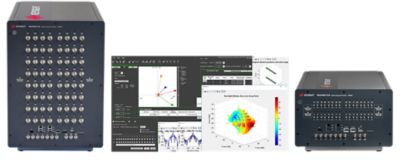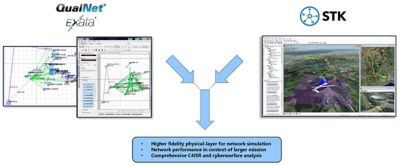-
Ansys is committed to setting today's students up for success, by providing free simulation engineering software to students.
-
Ansys is committed to setting today's students up for success, by providing free simulation engineering software to students.
-
Ansys is committed to setting today's students up for success, by providing free simulation engineering software to students.
-
Contact Us -
Careers -
Students and Academic -
For United States and Canada
+1 844.462.6797
ANSYS BLOG
December 13, 2022
Charting and Validating the Course Ahead with Keysight and Digital Mission Engineering
What if you could monitor, predict, and plan for the unseen in space or on Earth? Think of an airport — as flights prepare for takeoff, a number of planes approach the area to land. Airport traffic management is well-versed in these types of situations, but traffic bottlenecks go beyond the physicality of planes vying for runway space. There are invisible networks, signals, and frequencies emanating from these planes that cause interference with each other. Even the most advanced traffic controller might be unable to predict such variables or potential interference.
This is just one example of how Ansys and Keysight Technologies, a leading manufacturer of electronic test and measurement equipment, are helping customers see the unseeable to chart and validate the best course of action on the ground, in the air, and beyond. By pairing Keysight’s hardware and software validation solutions with Ansys Systems Tool Kit (STK) digital mission engineering platform, engineers and designers can ensure success in even the most complex missions.
Closing the Loop with Simulated Data
Keysight provides solutions for a range of industries, including aerospace and defense (A&D), telecommunications, consumer electronics, automotive, and industrial equipment — influencing many devices and systems that impact our daily lives. For example, your cell phone may have been designed and tested using Keysight’s verification tools, or your favorite internet service provider may have undergone rigorous cyber testing from Keysight to ensure its security and improve loading time.
These hardware-in-the-loop (HIL) and software-in-the-loop (SIL) solutions serve as an important bridge between simulation and real-life products. However, in certain scenarios, static simulations can only forecast so much, even with the best design validation tools. Radio frequency (RF) signals, for example — like all electromagnetic (EM) phenomena — are active, ever-changing, and in motion.
By integrating STK, designers and engineers achieve enhanced understanding of system performance and can explore design alternatives across dynamic platforms in STK's high-fidelity, system-of-systems ecosystem.
“A trend we’ve seen lately is performing more comprehensive simulations of systems during early conceptualization phases,” says Phil Lorch, director of the Space and Satellite Test Solutions business unit at Keysight Technologies. “The value of pairing Keysight and Ansys technologies is helping our customers accelerate through the stages of the product life cycle in a more streamlined way, from the earliest engineering using the STK platform for simulation through detailed design development and building the prototype with RF and network design simulation and then with hardware validation and HIL testing.”
Time-dynamic 4D system-level simulation is one of STK’s greatest assets. With STK, you can model complex systems inside a realistic simulation that includes high-resolution terrain, imagery, RF environments, and more. Further, you can select, build, and import precise models of ground, sea, air, and space assets and combine them to represent existing or proposed systems. Similarly, you can simulate the entire system of systems in action, at any location, and at any time, to gain a better understanding of system behavior and mission performance. In addition to saving time and costs, there is also a greater success rate for the first run of demonstration missions and initial integrations of different subsystem components.
“By using Keysight and Ansys tools together, you can compare measurement results with simulation results throughout the product life cycle, from design through validation and even actual operations — making a determination if the models need to be improved or if there’s something wrong in the hardware. It becomes a virtuous cycle as you go through iterations of a design,” says Lorch. “The value here is helping customers get through the loop a lot quicker and get their products and systems to their customers faster and in a much more reliable way.”
Another incentive for joint solutions is the A&D industry's push toward digital transformation.
Several governmental branches funded by the Department of Defense (DOD) — such as the U.S. Air Force and U.S. Space Force — are starting to mandate more thorough designs simulated using digital twin technology before accepting proposals or bids from system vendors.
“By linking our products together more seamlessly, we can help our customers meet governmental requirements for digital twins and accurate digital simulations with a high degree of reliability,” adds Lorch.

Simulation shown in Ansys STK integrated with Keysight’s PathWave System Design (formerly SystemVue) software, which offers component level design approaches for engineers to create digital representations of their anticipated radio frequency (RF) systems. This simulation illustrates an uplink-downlink situation utilizing a specified communications system and a phased array antenna design.
The ensured reliability is supported by Keysight’s renowned validation technologies, including three that are currently integrated with Ansys software:
- PathWave System Design (formerly known as SystemVue)
- PROPSIM channel emulators
- Network simulators such as QualNet and EXata, which are products they’ve adopted through their acquisition of Scalable Network Technologies
PathWave System Design is an RF-system-simulator that incorporates detailed and regularly-updated libraries of RF and microwave behavioral models used in communication systems. This enables RF system engineers to virtually prototype and simulate their phased array antennas, RF front-end and back-end architectures with very high fidelity before committing to hardware realization.
As demonstrated in the airport example earlier, using network simulators like QualNet or EXata in tandem with STK enables designers to simulate communication networks with a high degree of fidelity. These insightful joint workflows enable users to detect unseen interference and network traffic issues in scenarios with numerous simultaneous radio signals.

Keysight’s PROPSIM channel emulators bring hardware-in-the-loop (HIL) to the testing routine. These emulators can be integrated with the Ansys STK digital mission engineering platform.
Still, whether the mission is in its early stages or final stages, terrestrial or non-terrestrial, the Keysight-STK integrations provide insight in real time to improve performance and success, from the smallest details to full system analyses.
“The connection with Keysight is critical in getting users like system designers to the milestone portions of the product life cycle faster,” says Nate McBee, a senior manager of product management in digital mission engineering at Ansys. “It gives them an opportunity to go back and revisit their designs without having to rip apart design scaffolding or use piecemeal integrations. ”

Keysight’s QualNet and EXata network simulators enable designers to model the full network stack and understand how data would be delivered through a network of connected devices with multiple routes, priorities, and dynamically changing links. The QualNet/EXata-Ansys STK integration offers better prediction of performance such as latency and packet loss in operational environments by establishing highly realistic mission scenarios and improved levels of fidelity in the analyses of mobile communications.

These images illustrate the same scenario visualization in STK (left) and Keysight EXata (right).
A Wealth of Applications for Digital Mission Engineering
The potential for Keysight-STK integration is nearly limitless and extends beyond A&D with a wide scope of applications, many of which affect our daily lives — such as inflight Wi-Fi, transit system communications, cell phone reception, and satellite radio.

These images show Ansys STK modeling a ground-based network of cellular towers and repeaters with vehicles traveling within the designed environment to analyze connectivity, signal strength, and other metrics. Through a co-simulation with Keysight’s QualNet and EXata network simulators, the STK simulation can be used to analyze the performance of the entire network.
“Digital mission engineering brings in the dynamics. A lot of designs are static, saying, ‘Here are the requirements, go design and build this thing and you’re done,’” says Lorch. “But it doesn’t take into account the dynamics — what are the changing environmental conditions that are result of a mission profile? And it doesn’t have to be a military mission; it could be a task or challenge, like ‘I need to make sure I have a communication link that’s going to work for this ship from point A to point B and I don’t know if there will be cell towers along the way.’”
According to Lorch, digital mission engineering strengthens the concept of the mission from the start with the ability to account for the time variance of parameters, which improves design accuracy and product performance.
This can be demonstrated with the example of a satellite. While simulating a satellite in STK as it moves toward a ground station, Keysight test equipment can apply a Doppler shift to the signal as it crosses overhead and illuminate this with a spectrum analyzer. This collaboration provides insight that enables a more accurate simulation of an orbiting satellite in motion, including the shifting parameters of radio links between the satellite and ground station in real time.
The technology pairing can also help when disaster strikes. When the volcano erupted at Hunga Tonga-Hunga Ha’apai Island earlier this year, it severed undersea internet cables, obliterating communication with the outside world. It was satellite communications1 that allowed recovery teams to regain connectivity.
“Having a network that is robust, that’s been modeled very well, and can handle massive increases in traffic is really important and practical from a saving-human-lives standpoint and getting first responders and help to areas before ground networks have been reestablished,” says Lorch. “Through the Keysight-Ansys integrations, we can help ensure these robust, reliable, and critical systems work under normal as well as extreme conditions.”
Built on a Strong Foundation
The Keysight and Ansys relationship goes back more than a decade, beginning with Keysight and AGI, which was acquired by Ansys in 2020.
“For well over 10 years we’ve had some level of demonstratable scripting or integrations, and the recognition was, we’ve got a lot of joint customers and these tools are commonly used together, so there should be a more elegant integration between them that benefits all sides,” says McBee.
Today Ansys and Keysight’s streamlined and interoperable workflows combine industry-leading tools that enable engineers to accelerate the product life cycle, garner critical insights to improve decision-making, significantly reduce human error, and produce higher-fidelity designs.
“The power of what we can do across our two companies for our mutual customers is pretty amazing, and I would say unequaled,” says Lorch. “It’s a unique and comprehensive set of capabilities.”
To explore STK firsthand, request a free trial here.
To further explore Keysight’s integrated solutions with STK, please visit:










